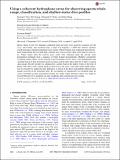Using a coherent hydrophone array for observing sperm whale range, classification, and shallow-water dive profiles
Author(s)
Tran, Duong D.; Huang, Wei; Bohn, Alexander C.; Wang, Delin; Gong, Zheng; Ratilal, Purnima; Makris, Nicholas; ... Show more Show less
DownloadMakris_Using a coherent.pdf (2.852Mb)
PUBLISHER_POLICY
Publisher Policy
Article is made available in accordance with the publisher's policy and may be subject to US copyright law. Please refer to the publisher's site for terms of use.
Terms of use
Metadata
Show full item recordAbstract
Sperm whales in the New England continental shelf and slope were passively localized, in both range and bearing, and classified using a single low-frequency (<2500 Hz), densely sampled, towed horizontal coherent hydrophone array system. Whale bearings were estimated using time-domain beamforming that provided high coherent array gain in sperm whale click signal-to-noise ratio. Whale ranges from the receiver array center were estimated using the moving array triangulation technique from a sequence of whale bearing measurements. Multiple concurrently vocalizing sperm whales, in the far-field of the horizontal receiver array, were distinguished and classified based on their horizontal spatial locations and the inter-pulse intervals of their vocalized click signals. The dive profile was estimated for a sperm whale in the shallow waters of the Gulf of Maine with 160 m water-column depth located close to the array's near-field where depth estimation was feasible by employing time difference of arrival of the direct and multiply reflected click signals received on the horizontal array. By accounting for transmission loss modeled using an ocean waveguide-acoustic propagation model, the sperm whale detection range was found to exceed 60 km in low to moderate sea state conditions after coherent array processing.
Date issued
2014-06Department
Massachusetts Institute of Technology. Department of Mechanical EngineeringJournal
The Journal of the Acoustical Society of America
Publisher
Acoustical Society of America (ASA)
Citation
Tran, Duong D., Wei Huang, Alexander C. Bohn, Delin Wang, Zheng Gong, Nicholas C. Makris, and Purnima Ratilal. “Using a Coherent Hydrophone Array for Observing Sperm Whale Range, Classification, and Shallow-Water Dive Profiles.” The Journal of the Acoustical Society of America 135, no. 6 (June 2014): 3352–3363. © 2014 Acoustical Society of America
Version: Final published version
ISSN
0001-4966